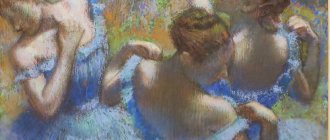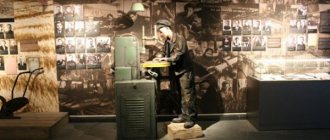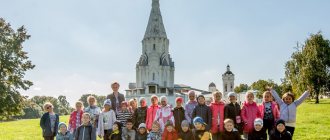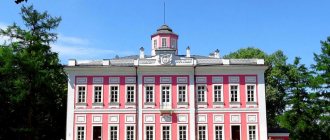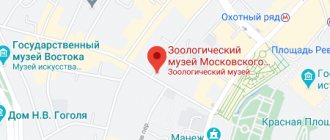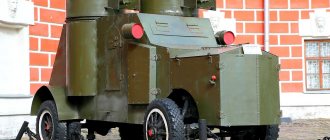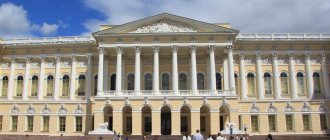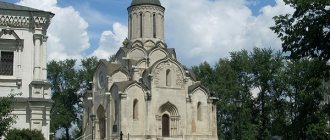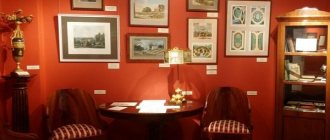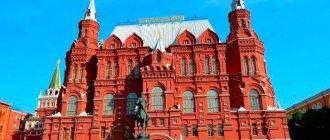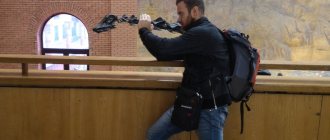TO BUY A TICKET
Tickets purchased on the Official website of the Moscow Mayor www.mos.ru can be issued for refund through the digital travel platform RUSSPASS. To issue a refund, send a request through the “Write to us” section on the website www.russpass.ru or by email
Services and prices
Entrance fees:
adult - 400 rub. preferential* — 150 rub. preschoolers (children under 7 years old) - free.
Evening visit to the exhibition complex on Thursdays from 18:00 to 21:00:
adult - 150 rub. preferential* — 50 rub. preschoolers (children under 7 years old) - free.
Entrance fee to the interactive multimedia exhibition “Walk the Path of Evolution”
if you have an entrance ticket to the museum,
an adult costs 70 rubles. preferential* — 30 rub. preschoolers (children under 7 years old) - free.
The cost of admission to the interactive educational
if you have an entrance ticket to the museum,
an adult costs 100 rubles. preferential* — 70 rub. preschoolers (children under 7 years old) - 30 rubles.
Birthday at the museum:
Cost of interactive excursions:
6,000 rub. for a group of children and adults up to 5 people 9,900 rub. for a group of children and adults up to 15 people (no more than 10 children)
Online program cost:
RUR 2,500 for a group of up to 10 children
Entrance tickets at the museum box office can be purchased in cash or by bank transfer. We accept cards from the following payment systems:
* The benefit is provided (upon presentation of a document) to full-time university students, ISIC card holders, schoolchildren, parents of large families and pensioners.
The following have the right to free admission:
preschoolers, Moscow schoolchildren (upon presentation of a social card or a Moskvenok card), orphans, disabled children, participants and disabled people of the Second World War, combat veterans, Heroes of the USSR, Heroes of the Russian Federation, persons awarded the badge “Resident of besieged Leningrad”, obese holders of the Order of Glory, disabled people I and II, soldiers and sailors of conscript service, museum employees, members of ICOM.
Disabled people of groups I and II are served out of turn (Decree of the President of the Russian Federation of October 2, 1992 No. 1157)
Amateur photography is free. Professional filming is carried out only in agreement with the administration
Free museum admission on Thursdays is suspended
according to the Order of the Moscow Department of Culture No. 39 dated June 11, 2021.
Attention! The museum has parking for 45 cars. On weekends and holidays the number of available places is limited.
History of creation
The museum appeared thanks to zoologist A. Kots, who collected a large collection of animals. Over time it grew, so a new building was needed. Despite constant requests to allocate money for its construction, the 6-story complex opened only in 2007.
Darwin Museum
The museum appeared in 1907 on the initiative of zoologist Alexander Kots. He brought his personal collection of animals and birds to the laboratory at the Higher Women's Courses, where he gave lectures. But the created institution was considered educational, since various exhibits were used for demonstration in classes.
Since 1922, thanks to the support of the Soviet government, the Darwin Museum became state-owned.
Excursions for school groups, lectures and seminars for biology students began to be held in 1966. After 12 years, the institution received the “Badge of Honor”, and in 1997 it became the main one in the Association of Natural Science Museums of the country. Twice (2007 and 2016) he was given the Grand Prix at the Intermuseum exhibition.
Building
The museum did not have its own building for 87 years. Due to the increase in the number of exhibits, the rooms in Merzlyakovsky Lane became small, so the animals and birds were moved to a building on Devichye Pole. In 1945, the construction of a new building began, but before the end of construction it was transferred to the choreographic school at the Bolshoi Theater.
The museum did not have its own building for a long time.
From 1974 to 1994 with long interruptions, they built another room. A year later, the museum opened its first exhibition for visitors. Due to the increase in the collection, the Moscow government allocated funds for the construction of a storage facility. The building, consisting of 6 floors, was put into operation in 2007. It hosts temporary exhibitions.
HISTORY OF THE MUSEUM
TO BUY A TICKET
Tickets purchased on the Official website of the Moscow Mayor www.mos.ru can be issued for refund through the digital travel platform RUSSPASS. To issue a refund, send a request through the “Write to us” section on the website www.russpass.ru or by email
Services and prices
Creation of a museum. Founders
The Darwin Museum was founded in 1907. F. E. Fedulov, A. F. Kots, N. N. Ladygina-Kots and V. A. Vatagin on display at the museum. 1912 A. F. Cots. 1914 Any bright cultural phenomenon begins with a creative personality. And for the Darwin Museum, such a person was its founder and permanent director until 1964, Doctor of Biological Sciences, Professor Alexander Fedorovich Kots (1880-1964). If it were necessary to characterize this extraordinary person in a few words, then the words - scientist, museologist and teacher - would most fully highlight the facets of Alexander Fedorovich's talent. Alexander Kots was born in Borisoglebsk in 1880 into the family of a German emigrant. The area of scientific interests of the future biologist was determined quite early. As a child, he was introduced to the rudimentary technique of taxidermy, which was the beginning of his passion for taxidermy. In 1896, the young preparer was awarded a small silver medal of the Russian Society for the Acclimatization of Animals and Plants for presenting a collection of stuffed birds of his own work at the poultry exhibition in the Moscow Zoological Garden. Alexander Kots making a stuffed bird. Ostankino. 1898 Fyodor Karlovich Lorenz, ornithologist, founder of the Moscow school of taxidermy. The successes of the novice biologist and taxidermist were not accidental. The decisive role, undoubtedly, was played by the acquaintance with Fyodor Karlovich Lorenz (1842-1909), a famous systematic zoologist and owner of the best taxidermy company in Moscow. The stuffed animals, made by experienced craftsmen of this company, were distinguished by high quality, dynamic and natural poses. Alexander Kots not only studied with experienced preparators from the F. K. Lorenz company, but also used every chance to expand his home collection. “Without Lorentz, there would not have been that most valuable core around which all subsequent acquisitions of the Darwin Museum were formed, multiplied, grew and strengthened,” wrote A.F. Kots. The long-term friendship of these people ended only with the death of Fyodor Karlovich. In order to preserve the integrity and save his priceless collections from “dispersion,” Alexander Fedorovich offered himself to Lorenz’s heirs as the company’s financial director. At his request, his salary was paid in effigies, and the workshop continued to provide Cots with exhibits at reduced prices. In 1901, Alexander Kots entered the natural sciences department of the Faculty of Physics and Mathematics of Moscow University. Fascinating lectures by M. A. Menzbier, V. I. Vernadsky, K. A. Timiryazev, A. P. Pavlov made me forget about my old hobby. Now all the proceeds from private biology lessons were spent on purchasing foreign literature on general biology. The works of Alfred Wallace, Hugo de Vries, August Weissmann, purchased by Alexander Kots in those years, are carefully preserved in the museum to this day. Auditorium of the Moscow Institute of Housing and Culture before A. F. Kots' lecture on Darwinism. 1907-1913 In 1907, Alexander Kots was invited to the Moscow Higher Women's Courses (MVZhK) to conduct practical classes on animal anatomy, and a little later the young teacher began to lecture on Darwinism. This event became a turning point in the fate of the museum and its founder. From the cramped apartment, the collection moved to the zoological laboratory of the courses and “... on the eve of the lectures, dozens of preparations were removed from cabinets and placed on tables in the classroom in the order prescribed by the role of each object.” The audience greeted the enthusiastic lecturer with attention and gratitude. The building of the Moscow Higher Women's Courses on Devichye Pole (now Malaya Pirogovskaya Street) A new direction for the acquisition of the museum was also determined. A.F. Kots wrote that the collections “were united according to individual chapters of evolutionary teaching: geographical, age and personal variability, adaptations, Mendelism, Lamarckism, the origin of man...”. Responses to piles of letters with orders to Germany, England, and France were not long in coming. “It was a rare week without parcels, a rare day that did not bring envelopes with a foreign stamp, and a rare hour without new plans for further additions to the museum,” Alexander Fedorovich later recalled. Part of the new exhibits was paid for by the zoological laboratory of the MVZhK, which was headed in those years by the outstanding biologist Nikolai Konstantinovich Koltsov; part of the collection was still purchased with funds from the founder of the museum. In 1913, the collection already numbered several thousand exhibits. A.F. Kots decided that such a unique collection could not be the property of one person, and transferred it to the MVZHK. Nadezhda Nikolaevna Ladygina-Kots and Alexander Fedorovich Kots. 1911 Nadezhda Nikolaevna Ladygina-Kots and Alexander Fedorovich Kots. 1959 In 1911, A.F. Kots married MVZhK student Nadezhda Nikolaevna Ladygina (1889-1963). “In a crowd of wonderful Russian girls, I guessed this one and only one in the world... Without knowing anything about her, without exchanging with her... not a single deep word, I found myself chained to her with my whole being,” wrote Alexander Fedorovich about Nadezhda Nikolaevna. A diligent student, the head of the biological circle, equally passionate about psychiatry and zoology, Nadezhda Nikolaevna later became a co-founder of the Darwin Museum, a famous animal psychologist, the author of many scientific works, and a Doctor of Biological Sciences. Half a century filled with difficult trials and joyful victories connected her with the museum. N. N. Ladygina-Kots worked on the creation of a zoopsychological department dedicated to the study of the behavior and psyche of animals, conducted excursions, advised artists, sculptors and taxidermists, and helped prepare excursions for young museum employees. Taxidermist F. E. Fedulov. 1930s A.F. Kots and F.E. Fedulov mount a stuffed African elephant. 1927 A.F. Kots considered the taxidermist F.E. Fedulov (1881-1962) to be the co-founder and supporter of the Darwin Museum. F. E. Fedulov worked at the Darwin Museum for more than forty years; he created more than a thousand exhibits for it. In 1927, the master was awarded the Order of the Red Banner of Labor; since then, not a single Russian taxidermist has been awarded such an award. It was sometimes not easy for the master to make a choice among the mass of materials accumulated in the museum, to establish the order and order of mounting hundreds of bird and animal skins that needed speedy dissection and salvation from the corrosive effects of fatty acids. It was necessary to process the material coming from the Moscow Zoo. In the 1930s Another source of replenishment of collections has appeared - the Moscow fur refrigerator. A.F. Kots selects skins at the Moscow Fur Refrigerator for subsequent production of stuffed animals. 1930s A.F. Kots wrote: “Years will pass, our Darwin Museum will have its walls worthy of its contents... Then and only then, in front of millions of future visitors... will the wonderful exhibits created by the talent, labor and enthusiasm of the most dedicated employee unfold in full co-founder of the Darwin Museum - Philip Evtikhievich Fedulov." During his trips to Western Europe in 1905 and 1913, A.F. Kots carefully studied and compared the exhibitions of the largest biological museums, which had long traditions and history. He drew attention to the lack of fine art in these museums. But, according to A.F. Kots, the Museum of Evolution required a completely new design - so, along with genuine natural science exhibits, it was decided to use painting and sculpture. This became possible thanks to collaboration with V. A. Vatagin and other animal artists. V. A. Vatagin is working on a sculpture of Charles Darwin. A.F. Kots poses. 1927 V. A. Vatagin works on the sculpture “Cro-Magnon Man with a Reindeer.” 1918 Vasily Alekseevich Vatagin (1883/84-1969), an outstanding Russian animal artist, full member of the USSR Academy of Arts, employee of the Darwin Museum from 1908 to the 1950s. A.F. Coats always called him the co-founder of the Darwin Museum. The museum's collections contain 158 sculptures, 372 paintings and 1,136 graphic works by V. A. Vatagin. The artist created for the museum a series of busts of the heralds of the idea of evolution: Lamarck, Goethe, Darwin. The materials used were engravings and photographs. V. A. Vatagin performed the sculptural compositions telling about the life of primitive man on the basis of the scientific data available at that time. The museum houses hundreds of “animal portraits”, the creation of which the artist worked from life. “Vatagin’s chisel and brush do not know ugly forms and ungraceful lines, he sees this beauty, this grace in every animal, in every turn, in every line of the animal...” wrote A.F. Kots about the artist. Vasily Alekseevich raised and mentored a galaxy of Russian animal painters. Since the late 1920s, talented artists began to gather around Vatagin in the Darwin Museum: A. Komarov, K. Flerov, D. Gorlov, N. Kondakov, A. Formozov, V. Trofimov, V. Belyshev, who also left a bright mark on history of the Darwin Museum. During the harsh years of revolution and civil war, full of confusion, terror, hunger and cold, the museum staff did not interrupt their work. Sculptures, paintings, stuffed animals were created in the unheated museum walls, and scientific research was conducted. The museum director was not only concerned with the issues of acquiring collections. He developed exhibition and lecture methods for promoting evolutionary teaching. A. F. Kots - an excellent lecturer, an excellent teacher and museologist - personally gave lectures and conducted excursions for half a million people. His brilliant lecturing talent left no one indifferent. The archive contains hundreds of grateful letters and enthusiastic reviews addressed to Alexander Fedorovich. A.F. Kots conducts an excursion for a group of cultural workers of state farms on the topic “Methods of selection in animal husbandry.” March 2, 1930 A.F. Kots with a group of students from working youth school No. 116 in Moscow. 1961 Despite the endless worries about the museum, Alexander Fedorovich found time for scientific work. He is the author of more than two hundred museum studies. Today we turn to them again. In 2013, the museum began publishing the Collected Works of A. F. Kots. His works have not lost their relevance and are classics of museology - this is evidenced by the continued interest of readers. A.F. Kots in his office at the typewriter. 1940s The museum exposition is overcrowded with exhibits. 1950s The director’s main concern and pain for many years was the construction of a building for the museum. He suffered the bitterness of injustice when the museum was closed due to the emergency condition of the premises, the hassle of constructing a museum building, and endless grief when construction was stopped and the foundation (on Frunzenskaya Street) was transferred to another institution. A.F. Kots never saw the museum in his own building.
1964—1988
In 1964, the life work of A.F. Kots was continued by Vera Nikolaevna Ignatieva (1904-1991). “While performing various current work, I always remembered that I came to this museum to work in order to worthily use the enormous opportunities of collections of museum values for the education and upbringing of the people. All the time there was a question about premises to create normal working conditions for the museum,” wrote Vera Nikolaevna. In 1968, she was able to achieve a new decision on the construction of a building for the museum. Vera Nikolaevna Ignatieva - director of the museum 1964-1986. On Pirogovskaya Street, in the old museum building, work was in full swing. The staff tried their best to bring the museum out of conservation (the exhibition of the Darwin Museum was closed to visitors due to “extreme neglect and unsanitary condition of the premises”), they put the exhibition halls, walls, windows in order... P. P. Smolin conducts a tour for schoolchildren. 1967 At this time, Pyotr Petrovich Smolin (1897-1975), the chief curator, founder and leader of the biological circle of the All-Russian Society for Nature Conservation (VOOP), worked at the museum. P.P. Smolin considered working with young people the greatest work of his life, he wrote: “Over the years of working with young people, I managed to raise more than a hundred biologists - from doctors of science to novice scientists. This gives me satisfaction more than anything else.” Even in the absence of an exposition, P.P. Smolin conducted classes and various seminars on biology for teachers. In 1966, the Department of Culture allowed the exhibition to be opened to serve school groups. The process of replenishing funds with gifts and materials brought by employees from expeditions gradually intensified. At the end of the 1970s. under the leadership of Vera Nikolaevna Ignatieva, a scientific concept of the exhibition was created for the building that was being built on the street. Vavilova. The museum attracted the most prominent biologists and animal artists as consultants. V. N. Ignatiev demonstrates the project “Charles Darwin Hall”. 1970s S. K. Klumov, Chairman of the Scientific Council of the Darwin Museum and Director V. N. Ignatiev at a meeting of the Scientific Council of the museum. 1970s Valentina Semyonovna Oreshnikova (1946-1989) - chief curator of the Darwin Museum from 1979 to 1989. Under Valentina Semyonovna, the museum’s funds were actively replenished. Museum staff, teachers and graduate students of higher educational institutions conducted seminars for students and schoolchildren, “Biological Fridays” (a seminar for biology students) at the museum. The museum did not stop active exhibition activities, organizing traveling exhibitions in many cities in Russia and abroad. All this - traveling exhibitions, lecture work, and connections with television programs - worked for the authority of the museum. In 1978, the Darwin Museum was awarded the Order of the Badge of Honor for the promotion of natural science knowledge and active educational work. Museum director V. N. Ignatieva and deputy director for scientific work V. M. Nezhina (in the center) and members of the presidium of the gala event on the occasion of awarding the Darwin Museum the Order of the Badge of Honor for services to the promotion of natural science knowledge. December 1978. Fragment of the exhibition “Hunting Trophies”. 1981 The museum exhibits presented at the EXPO-81 exhibition in Plovdiv (Bulgaria) were awarded the Grand Prix, 3 gold and 3 silver medals. Mobile exhibition of the Darwin Museum “Animal World of the Center of Russia” in the city of Vladimir. 1982 Emergency condition of the premises. 1984 Construction of the new building, which began in 1974, proceeded slowly and the old halls were destroyed; in 1984, the exhibition of the Darwin Museum was finally closed to visitors due to the emergency condition of the premises. Svetlana Alekseevna Kuleshova - director of the Darwin Museum from 1986 to 1988. In 1986, Svetlana Alekseevna Kuleshova (1940-2019) became the director of the Darwin Museum. In a short period of time, she did a lot to improve the accounting of stock collections, organized a complete reconciliation with accounting documentation and spared no effort in constructing a building for the museum. At this time, taxidermists worked in the museum: Kaleria Aleksandrovna Voronkova (1947-2014) and Nikolai Konstantinovich Nazmov (1907-1997). They were actively involved in the process of preparing the exhibition in the new building being built for the Darwin Museum on the street. Vavilova. In December 1986, S. A. Kuleshova invited Anna Iosifovna Klyukina to the position of deputy director for scientific work, who subsequently took up the baton and became the fourth director of the museum. Taxidermist K. A. Voronkova. 1980s Taxidermist N.K. Nazmov in the workshop of the Darwin Museum making a boar's head. 1988 Deputy Director for Scientific Work A.I. Klyukina makes a report at a meeting of the museum’s scientific council. 1987
1988—2000s
In 1988, Anna Iosifovna Klyukina was appointed director of the Darwin Museum. She took upon herself the burden of caring for the museum building on the street. Vavilova; she wrote hundreds of letters to various authorities asking to continue construction. By this time, the need to build a storage facility had already become ripe, since it became obvious that it would not be possible to house all the collections in the new building. The number of letters sent by the museum administration in 1988 was 40; in 1991, this figure almost doubled. Director of the Darwin Museum A.I. Klyukina in her office. May 5, 1990 This is what the rooms looked like in the old building of the Darwin Museum. 1993 At this time, the museum's scientific team was intensively developing a new exhibition (the building took so long to construct that the previous scientific concept of the exhibition, adopted in the 1970s, became outdated). From 1987 to 1993 Almost all thematic and exhibition plans were developed, a plan for arranging display cases throughout the museum was adopted, the dimensions of display cases and their number were determined, and most of the installation sheets for the exhibition were prepared. The museum staff had to build a permanent exhibition on an area of 5,000 square meters. m! For training purposes, six of them went on an internship at the largest natural science museum in the world - the London Natural History Museum. Largely thanks to this, not only the exhibition, but also the entire work of the Darwin Museum in the new building was able to be organized at the European level. While the exhibition was closed, the museum's exhibition activities did not stop. At various venues (in exhibition halls, at VDNKh, in clubs, cinemas, schools), museum staff organized thematic exhibitions. The Darwin Museum has also been a participant in major international exhibition projects. The exhibition of the Darwin Museum “Dialogue with the Past”, dedicated to the 85th anniversary of the birth of K. K. Flerov, was held in the Sokolniki exhibition hall. 1989 Visiting exhibition of the Darwin Museum “Birds and Animals of Russia” in Italy (Ancona). 1991 Lectures were carried out by museum staff in schools, vocational schools, colleges, clubs, and they always took with them interesting exhibits and photographs to illustrate the story. Twice a week, a circle of young biologists held classes in a small foyer, and once a week a circle of young animal artists met. These circles still operate in the museum to this day. In the 1990s, the museum’s funds were actively replenished through expeditions of museum researchers. The geography of expeditions is extensive: Kazakhstan, Pamir, Far East, Caucasus, Arkhangelsk region, Lake Baikal, Southern Yamal, Western Siberia, Turkmenistan, Dagestan, Central Tien Shan, Altai, Sayan Mountains, Tyumen region, Priuralsky district, Primorsky Krai, Kyrgyzstan, Beloye sea, Kalmykia. New exhibits were purchased annually. The museum accepts many donations during this time. Great attention was paid to the state of the museum's funds. Work was done to improve the accounting and storage of collections (almost all card indexes were created anew, forms of scientific passports were developed for each storage group, curators began to describe the collections in more detail). It was at this time that the Darwin Museum was one of the first in Russia to create electronic databases. Moving stuffed elephants to a new building. August 8, 1994 Construction of the exhibition in the “Diversity of Life on Earth” hall is underway. 1995 Finally, in 1994, the museum began moving to a new building. A.I. Klyukina recalls those events as follows: “In December 1994, part of the research team moved to a new building. The collections were transported almost simultaneously with the construction of the exhibition, which was incredibly difficult for us. Suffice it to say that the employees transported about four hundred thousand storage units and installed almost five thousand square meters of exhibition!” Moscow Mayor Yu. M. Luzhkov and museum director A. I. Klyukina inaugurate the new building. September 2, 1995 100th anniversary of the museum. The opening ceremony of the exhibition complex with a storage facility. April 21, 2007 On September 2, 1995, on City Day, Moscow Mayor Yu. M. Luzhkov inaugurated the first exhibition halls of the museum. “For us it was a completely unforgettable event,” writes Anna Iosifovna, “the dream of the museum’s founder, Alexander Fedorovich Kots, came true: the Darwin Museum opened the doors of a new building. True, we had to wait 88 years for this event.” For its 100th anniversary, in 2007, the museum received a long-awaited gift - a storage building, which, in addition to storage facilities, housed spacious exhibition halls, curator's offices, a cafe, and a museum store. Now the Darwin Museum is fully operational in all areas of activity: it holds more than 60 exhibitions a year, creates new interactive complexes and expositions, is engaged in cultural, educational and research work, pays a lot of attention to environmental education of citizens, and actively replenishes and studies its funds. The museum rightfully occupies a worthy place among Russian and foreign museums, receiving more than 600,000 visitors annually. Light-video-musical exhibition “Living Planet”. 2002 Visitors at the interactive exhibition “Walk the Path of Evolution.” 2010 Visitors to educational interactive multimedia. 2015 Excursion to the Darwin Museum paleopark. 2021 “An unboring evening” on the roof. 2021 At the exhibition “All the Colors of Asia”. September 2016 Lesson in information. 2021 “Silver Volunteers” of the Darwin Museum. 2021 Preschool Academy Celebration at the Museum. September 2021 On the ecological trail of the museum. 2021 New holiday at the museum - Penguin Day. February 1, 2020
Construction of the museum
The Darwin Museum was founded by a young teacher of Darwinism, Alexander Fedorovich Kots (1880-1964), at the Moscow Higher Women's Courses (now the Pedagogical University) in 1907.
The museum was allocated premises in the MVZhK building, where the museum operated until 1994, i.e. For 87 years the museum did not have its own building. Even before the 1917 revolution, the founder and permanent director of the Darwin Museum tried to find patrons to build the museum its own building. After the revolution, he unsuccessfully approached V.I. Lenin with a request for the construction of a building. Surprisingly, an appeal to I.V. Stalin, and even after the most difficult Great Patriotic War, brought results. In 1946, the Council of Ministers of the RSFSR adopted Resolution No. 79 on the design of its own building for the GDM and the allocation of 100,000 rubles for these purposes. The Resolution spoke about the need to quickly resolve the issue of constructing a new building for the Darwin Museum. On September 1, 1952, A.F. Kots, N.N. Ladygina-Kots and F.E. Fedulov sent a letter to the Kremlin personally to Comrade Stalin with extensive annexes and a detailed justification for the need to build a new building for the GDM “in pursuance” of Stalin’s order “to catch up and surpass the cultural achievements of foreign capitalist countries.” Covering letter to documents about the museum, addressed to I.V. Stalin. 1952 On August 1, 1953, decree of the Council of Ministers of the RSFSR No. 3902-r “On the construction of a school-type building to house the GDM” was issued, with which A.F. Kots categorically disagreed. His two-year struggle with this decision yielded results. Project of an individual building for the Darwin Museum In 1955, the RSFSR Council of Ministers issued an order No. 1119-r on the development of a special project for the construction of a building for the Darwin Museum, and in the same year the Moscow City Executive Committee issued an order to allocate a new plot of land for the construction of the museum on M. Trubetskoy Street. The commissioning of the new building of the Darwin Museum was planned for 1957. But only in 1958 a joint Decree of the Council of Ministers of the USSR and the Central Committee of the CPSU was issued on the construction of a building for the Darwin Museum. In 1958, the Executive Committee of the Moscow City Council adopted decision No. 11/12 on the allocation of land for the construction of a new building for the Darwin Museum on 3rd Frunzenskaya Street. On February 22, 1959, at a meeting with the Secretary of the City Committee of the CPSU, who oversees capital construction issues in Moscow, it was decided to build a museum building on an allotted site in 1960–1961. For these purposes, 2 million rubles were allocated. Construction began only in October 1960, and 1 million rubles from the allocated amount were transferred by the Capital Construction Administration to other projects. In 1960, the foundation was laid for the new building of the Darwin Museum on 3rd Frunzenskaya Street. In 1961, the Executive Committee of the Moscow City Council decided to transfer the land plot allocated by decision of the Executive Committee of the Moscow City Council No. 11\12 dated January 25, 1958 for the construction of a new building to the Darwin Museum - for construction Choreographic School of the Bolshoi Theater. A.F. Kots fought desperately to save the museum. The leadership of the Department of Culture proposed to “close the museum and distribute the stuffed animals to schools so that there would be no problems with construction.” The museum was completely deprived of all funding. View from the courtyard of the entrance to the Darwin Museum. Late 1950s - early 1960s In 1964, A.F. Kots died without realizing his dream of moving to a new building. Vera Nikolaevna Ignatieva (1904-1991) was appointed the new director of the museum; thanks to her efforts, the Darwin Museum was built on Vavilova Street. In 1965, V. N. Ignatieva initiated a letter from academicians B. E. Bykhovsky, A. N. Belozersky, A. L. Kursanov, M. I. Kabachnik, A. N. Nesmeyanov and A. I. Oparin to the First Secretary of the Central Committee CPSU to L.I. Brezhnev with a request to build a building for the Darwin Museum. The active efforts of V.N. Ignatieva led to the fact that on September 9, 1967, the USSR State Construction Committee issued permission for the individual design of a building for the museum. On July 25, 1968, at a meeting of the Moscow City Party Committee, it was decided to include the construction of a building for the museum in the design work plan for the next (1969) year. On February 8, 1968, Order No. 239 of the Executive Committee of the Moscow City Council was issued on the allotment of a land plot on the street. Vavilov (corner of Vavilov St. and Dmitry Ulyanov St.) for the construction of a new museum building based on an individual project. In 1972, the Executive Committee of the Moscow City Council approved the technical design and working drawings of a new building for the Darwin Museum. Resolution of the Executive Committee of the Moscow City Council No. 239 of February 8, 1968. Model of the new building of the State Darwin Museum. 1969-1970 In 1974, construction began on the allocated site. Hundreds of letters to various authorities were written by V.N. Ignatieva, and after 1986 by A.I. Klyukina with a request to continue construction. Beginning of construction of a new building for the Darwin Museum. 1975 Construction of a new building for the Darwin Museum. 1977 Construction of the Darwin Museum building. 1983 Construction proceeded extremely slowly. So slowly that trees and shrubs managed to grow through the slabs. The unfinished new building of the Darwin Museum. 1992 The total weight of papers submitted to various authorities regarding the construction of our own building for the Darwin Museum was 40 kg. On June 29, 1991, a board meeting of the Moscow Construction Committee was held, where it was decided to commission the museum in the 4th quarter of 1991. And already on February 25, 1992, the museum building under construction was included in the list of sales of unfinished objects. Moreover, on February 18 of the same year, an answer came to Alexei Vladimirovich Yablokov, who then held the position of State Advisor of the RSFSR on Ecology and Health, from the Moscow Construction Committee, where he had addressed a letter about the unacceptable delay in the construction of the museum, and received a response saying that in December 1992 the building would be completed. put into operation, and on February 25 the museum was already on the list for sale at auction. In December 1994, the building with numerous shortcomings was transferred to the museum. It took so long to build that it became obvious that it was not enough for the museum, and in 1994 they managed to achieve Moscow Government Resolution No. 360 on the construction of a storage facility for the State Darwin Museum. In 1995, the Mayor of Moscow Yu. M. Luzhkov and the Director of the State Historical Museum A. I. Klyukina opened the first exhibition hall in the new museum building for visitors. In 1997, construction began on a storage building for the Darwin Museum and in 2007 the building was put into operation. The construction of the storage building began with the laying of the heating network pipes. 2001 Construction of the Darwin Museum storage facility. March 2006 Museum Awards
© State Darwin Museum, 2021 8, Agreement on the processing of personal data [email protected] Site map
Independent assessment | Rate our museum
Formation of collections
The collection includes more than 40 thousand exhibits, the basis of which are stuffed animals from the personal collection of Alexander Kots. The number of animals increased thanks to the biologist Fyodor Lorenz, who owned a taxidermy workshop in Moscow. The director of the museum collaborated with drug preparation companies abroad. In 1913, he brought new exhibits from Great Britain and Germany.
In the 1930s The museum began cooperation with Soyuzpushnina, which supplied animals with rare anomalies. Now the museum owns more than 10 thousand abberants (animals and birds with a color different from the standard species). Thanks to a large collection of books (9 thousand works about nature), the Rare Book Foundation was founded. The following exhibits are considered the most valuable:
- first edition of On the Origin of Species;
- “Noah’s Ark” by the German inventor A. Kircheri;
- “The History of Snakes and Dragons” by U. Aldrovandi;
- “Herbarium of Ambon Island” by biologist G. Rumph;
- “Birds of America” by D. Audubon.
“The Origin of Species” is the most valuable exhibit in the museum.
The works of artists and animal sculptors are presented here. The walls are decorated with works by V. Vatagin, K. Flerov, V. Trofimov, A. Komarov. The building contains busts of primitive people, sculptures of birds and animals.
Museum exhibitions
In a building on the street. Vavilova, 57, thematic exhibitions are held on each floor. A “Paleopark” has been created here - an area in front of the entrance, which includes sculptures of prehistoric animals. On the ground floor, visitors are shown videos of animals inhabiting different natural areas of the planet.
"Paleopark"
The exhibition has been open to visitors since 2015 on the site near the museum. Its goal is to introduce people to the prehistoric animals that inhabited the territory of Russia. The following exhibits are installed in the Paleopark:
- mammoth;
- cave lion;
- woolly rhinoceros;
- kylex;
- lobe-finned fish panderichthys;
- Amurosaurus;
- Estemmenosuchus lizard;
- Mastodonsaurus
“Paleopark” introduces people to prehistoric animals.
Plants that grew in ancient times are planted in the yard. For convenience, there are benches, lanterns, and walking paths.
Installation “Living Planet”
Every Saturday and Sunday at 16.00, a 20-minute performance is held for visitors on the ground floor of the Darwin Museum. On the walls of the hall “The Diversity of Life on Earth” a video film is shown, which is accompanied by surround sound and special lighting effects. The 34 m long panoramic screen shows the history of the development of life on the planet. Endless savannas give way to the tropics, and oceans give way to mountain peaks and northern lights. Footage for the video was provided by the National Geographic Channel.
Exhibition complex
We go down again to the first floor and walk through the gallery into the exhibition complex building. Here, on the ground floor, there is a small cafe where you can have a snack.
The exhibition halls of the Darwin Museum are smaller in area than those in the main building. But there are five floors here, not three. On the ground floor there is a cafe and a locker room, on the second there is a small exotarium with butterflies in enclosures, spiders, cockroaches and other insects.
There is also a 5D interactive attraction where you can take a fascinating journey into the past and complete a very important task.
On the third floor you can visit the digital planetarium and the inventive laboratory of the CMIT BionicLab.
The fourth floor is a real educational laboratory, where amazing microscope research, scientific experiments, DNA extraction and much more are carried out. Here you can also visit the interactive multimedia exhibition “ Walk the Path of Evolution ” and an interactive group game in 3D format.
The museum's ecological trail, covering an area of 1,600 square meters, includes more than a hundred species of trees, shrubs and herbaceous plants. An extensive network of paths runs between them, allowing you to get up close and personal with each one. There are informational signs near the plants, and there is also an interactive panel along the trail.
In the paleopark , surrounded by ancient conifers, ferns and ginkgos, there are life-size models of ancient animals - the dinosaurs Amurosaurus and Kilescus, the “terrible-headed lizard” Estemmenosuchus, the lobe-finned fish Panderichthys, the giant amphibian Mastodonsaurus and the legendary “northern elephant” mammoth.
The Darwin Museum uses modern multimedia technologies: audio broadcasts of the voices of birds and animals, a light-video-musical exhibition “Living Planet”, an information and interactive complex “Travel with Animals” equipped with augmented reality technology has been installed.
Family excursions
The museum's collection includes stuffed animals and birds from different continents. Each display is dedicated to the age, geographic or sexual changes of species. Exhibits of animals with anomalies and marine life are of interest. On the third floor there is an area showing the evolution of man.
First floor
It is occupied by the “Diversity of Life on Earth” hall. The exhibition includes animals and birds that live in different natural areas and bodies of water. The pride of the museum is the savannah, where there are stuffed African elephants, zebras, giraffes, and hyenas. To the left of it is a showcase dedicated to the rainforest. Here the child will see an orangutan, a Himalayan bear, lemurs, a jaguar, and a flying squirrel.
"The Diversity of Life on Earth" includes animals and birds.
On the right side, visitors can look at animals living in the mountains (irbis, mountain sheep, black grouse). Next is a display case with penguins, a walrus, and an albatross.
On the ground floor, the Bathyscaphe exhibition, which displays the seabed and its inhabitants, is of interest.
Second
The room is divided into 2 large zones. The Microevolution hall displays exhibits that show sex, age and individual changes in animals of the same species. Stuffed tigers and leopards from different habitats demonstrate the geographical variability of the species. Several display cases on the floor are dedicated to animals with genetic abnormalities. The second part of the space includes exhibits related to the development of biology as a science.
Third
On the third floor, 3 different zones have been created. In the Zoogeography hall, animals and birds are divided according to geographical principles. The exhibition “Macroevolution” shows the changes in life on Earth from the Archean era to the present. There are skeletons of dinosaurs and prehistoric mammals here. The last zone is dedicated to the stages of human development.
Zoogeography shows changes in life on Earth.
Halls of the Darwin Museum
The Darwin Museum has several rooms, each dedicated to a specific topic. In addition to the main building of the museum, there is also an exhibition complex connected to the main building by an underground corridor.
Various temporary exhibitions are organized on the ground floor. A small area is reserved for a hall telling the history of the museum. The office of A.F. is shown here. Kots, there are photographs on the stands on the walls telling about his life and work.
There is also an interactive cinema hall with amazing opportunities for exploring our world, and a small exhibition hall.
The next room shows how diverse the animal world of our planet is - inhabitants of water, forests, mountains and even volcanoes. Here are the inhabitants of the savannah, and the inhabitants of the tropical jungle, mountainous regions of the Earth and the ocean. All stuffed animals or models of animals are behind glass; you cannot touch them.
On the territory of this hall, a twenty-minute light-video-musical exhibition “Living Planet” is shown every day, telling about life on earth over the past 4.5 billion years with the help of video, surround sound, light and special effects, turning the entire hall into a grandiose installation.
Next, go up to the second floor. The first hall tells how the process of man's knowledge of nature took place, starting from Antiquity, ending with Charles Darwin with his theory of evolution. There is an alchemist's office , a model of the Beagle ship on which Charles Darwin traveled, and an interactive panel that shows human anatomy.
It is very interesting to observe how the geometric progression of mouse reproduction . One pair of mice can produce six pups up to six times a year. After six weeks, these offspring can give birth to their own offspring.
The next room is dedicated to microevolution . This theory studies evolutionary processes in populations that lead to the formation of two or more new species from one ancestor. The exposition of the hall includes four themes.
The first section talks about the different forms and mechanisms of the occurrence of hereditary variability. Natural selection can operate differently in different populations of a species, resulting in geographic variation and, over time, the emergence of new species.
The exhibition in the “species and speciation” section tells in detail about these processes. After the process of speciation is completed, individuals of the newly emerged species are able to coexist within a single community.
The final section of the hall talks about the different types of relationships between species in communities and how these relationships lead to the formation of the integrity and sustainability of the entire community.
Just as no two people are exactly alike, no two individuals of any other species are exactly alike. Thus, using the example of a fox, the variability of individuals is shown depending on the geography of residence , as well as sexual variability using the example of lions and peacocks (differences in the color of males and females).
In the back on the third floor there is a beautiful “Zoogeography” hall with animals from all over the world behind large panoramic windows. The hall features an interactive complex “Travel with Animals”, with the help of which animals “come to life” thanks to augmented reality technologies.
The Galapagos tortoise, ring-tailed lemur, African ostrich, lion and antelope will come out to the one who stands on the small black circle, not giving the opportunity to doubt the reality of what is happening. Next door is a hall dedicated to macroevolution , including the origins of man, genetics, interaction with nature, the evolution of behavior, etc.
In the museum's lobby, scientific films are shown about how life originated in water, how animals eventually settled on land, how dinosaurs became extinct, etc. Projectors suspended from the ceiling simultaneously transmit images to two walls.
This completed the inspection of the main building.
Children's programs
This museum is popular with children. Here you can spend your child’s birthday and sign up for a bio-club. For young children there is an educational program “Preschool Academy”. During classes they will learn interesting facts about animals and birds. In the Zoogeography hall there are small labels on the walls with animal skins that you can touch. The museum provides the following additional programs:
- "Who left the trace?" Children over 6 years old are taught to recognize animal tracks.
- "PROinsects". Visitors will explore the Darwin Museum's collection of butterflies and insects.
- "The Kingdom of Mushrooms" During the classes, the child learns interesting facts about mushrooms and learns to divide them into edible and inedible.
- "Sericulture Lesson" Museum workers show real silkworms and help you obtain silk thread.
Children ages 4 to 7 will enjoy the Journey to the Past program. They are allowed to touch fossils, make a cast of a dinosaur skeleton, and visit a Neanderthal cave. As part of other projects, young visitors can examine insects and bird feathers under a microscope and become familiar with the fauna of Moscow and the Moscow region in detail.
Practical information
The institution is open every day except Monday. The museum is easily accessible by public transport or car. Free entry is provided for some visitors.
Address: how to get there
There is a parking lot for 60 spaces near the museum, so you can come by car. If you go by metro, you need to get off at the Universitet station. The museum can be reached by trams No. 14, 39 or buses No. 57, 119, 529 and 434. The second option is to walk from the Akademicheskaya station. At the underground passage you need to turn right, then at the intersection turn left onto the street. Dm. Ulyanov. Continue straight along it for 10-15 minutes.
Darwin Museum on the map.
Operating mode
The museum is open to visitors from Tuesday to Sunday from 10.00 to 18.00. On Thursday, opening hours change from 13.00 to 21.00. The interactive center is open until 20.00. Day off is Monday.
Ticket prices
For adults, a ticket costs 400 rubles, for preferential categories - 150 rubles. On Thursday, to visit the complex you need to pay 50-150 rubles. To visit the interactive, an adult pays 100 rubles, a benefit recipient pays 70 rubles. The cost of a ticket for children's programs is 200 rubles. (for a child over 7 years old and an adult).
The preferential category includes full-time students, schoolchildren, pensioners, and large families.
Free entry is provided for the following categories:
- museum staff;
- participants of the Great Patriotic War;
- children under 7 years old, disabled people and orphans;
- heroes of the USSR and Russia;
- persons with disabilities of groups I and II;
- soldiers who are undergoing military service.
Visitors can purchase an e-voucher in advance. The exchange is carried out out of turn in the control area by scanning the barcode.
Contacts
The excursion is organized by the bureau, which is available by phone. 8. To hold a child’s birthday party on the museum grounds, you need to call or.
